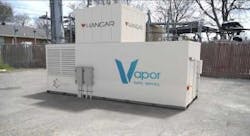Edge Computing and Why It Matters, In 2020 and Beyond
A new special report from Data Center Frontier highlights how a newly distributed workforce has reinforced the case for edge computing, which extends data processing and storage closer to the growing universe of devices and sensors at the edge of the network. We launch our timely series below as the data center industry continues to evolve amid the COVID-19 pandemic.
Get the full report.
In 2020, edge computing is entering a key transition phase, as an emerging ecosystem confronts the challenges and opportunities of a world transformed by the COVID-19 pandemic. Key players are beginning to deploy more edge data centers, navigating a sharp economic downturn, even as a massive shift to home-based work creates new opportunities for distributed computing.
Edge computing could have a transformational impact on global society and business, enabling new technologies and services across low-latency wireless connectivity. Some technologists believe edge computing will unleash a new world of powerful mobile devices unencumbered by limitations on compute power and data.
Consultant and futurist Chetan Sharma projects the edge economy will reach $4.1 trillion by 2030. The State of the Edge 2020 report from the Linux Foundation projects that edge investment will accelerate after 2024, with the deployed global power footprint of edge IT and data center facilities forecast to reach 102,000 megawatts by 2028, with annual capital expenditures of $146 billion.
The technology world is somewhat divided about the short-term prospects for edge computing. The split is not about whether edge computing will be useful, but whether – and when – it will be profitable. That’s why the economics of edge computing will come into sharp relief in 2020. End users and investors will focus on near-term cost/ benefit analyses rather than long-term potential.
How Data Center Frontier Sees the Edge
At Data Center Frontier, we continue to see a large opportunity for edge data centers, a view that is reinforced by our discussions with many veteran data center executives.
We believe edge computing will play out over many years, boosted by the gradual adoption of technologies with long deployment horizons. This timeline will be the backstory behind many of the headlines in edge computing this year.
Even before the outbreak of the COVID-19 pandemic, it was clear that there would be successes and disappointments in 2020, and both the “edge boom” and “edge hype” scenarios will factor into an active merger and acquisition landscape.
A Vapor Edge Module with a Hangar drone system mounted on the top of the modular data center. (Image: Vapor IO)
This revolution won’t be cheap. Many executives predict the buildout of edge computing will pressure the economics of digital infrastructure, leading to the creation of affordable deployments using repeatable form factors. Perhaps most importantly, most edge data facilities will be unmanned, remotely managed and highly automated.
There are signs of maturity and emerging leadership in the edge computing sector, most notably in the success of Vapor IO, which in January unveiled a Series C equity funding of $90 million, allowing the company to build out infrastructure in 36 cities by the end of 2021.
Vapor IO has also made an alliance with Digital Realty, the world’s largest wholesale data center operator. The companies have unveiled an “edge-to-core” offering for joint customers in three markets—Chicago, Dallas and Atlanta—with more to come. This offering could serve as a model for how colocation providers and edge specialists partner on integration.
Not every edge project will succeed. With a fluid ecosystem and product segmentation, many promising ventures may struggle to locate a profitable niche.
Not every edge project will succeed. With a fluid ecosystem and product segmentation, many promising ventures may struggle to locate a profitable niche. With most investors wary of speculative projects, expect to see consolidation as stronger incumbents and well-funded platform builders seek to “bolt on” promising edge players that run short of funding. Other initiatives may not survive.
Many venture capital and private equity investors are urging belt-tightening for their portfolio companies. Given the capital-intensive nature of the data center business, this could create a more challenging environment for startups requiring additional funding to reach profitability.
The competitive landscape is also being influenced by the growing activity of tower operators like American Tower and SBA Communications, whose financial strength and massive real estate holdings position them as potentially important players – as either partners or rivals – in the edge computing ecosystem.
Meanwhile, all the major cloud players have huge ambitions in edge computing, and are extending their footprints and product sets to capture early adopters. These platforms have enormous amounts of capital and the ability to deploy capacity quickly through existing relationships with data center providers and telecom companies.
To help our readers understand this complex landscape. Our new special report and article series provides in-depth insights on these topics:
- Edge Computing Business Cases
- Significant Players in Edge Computing
- The role of Tower REITs and Cloud Platforms
- Three Considerations when Deploying Edge Computing
Download the full report, courtesy of Chatsworth Products, “Edge Computing: A New Architecture for a Hyperconnected World,” that explores the possibilities of the edge data center and how edge computing is changing the colocation and data landscape of today.







